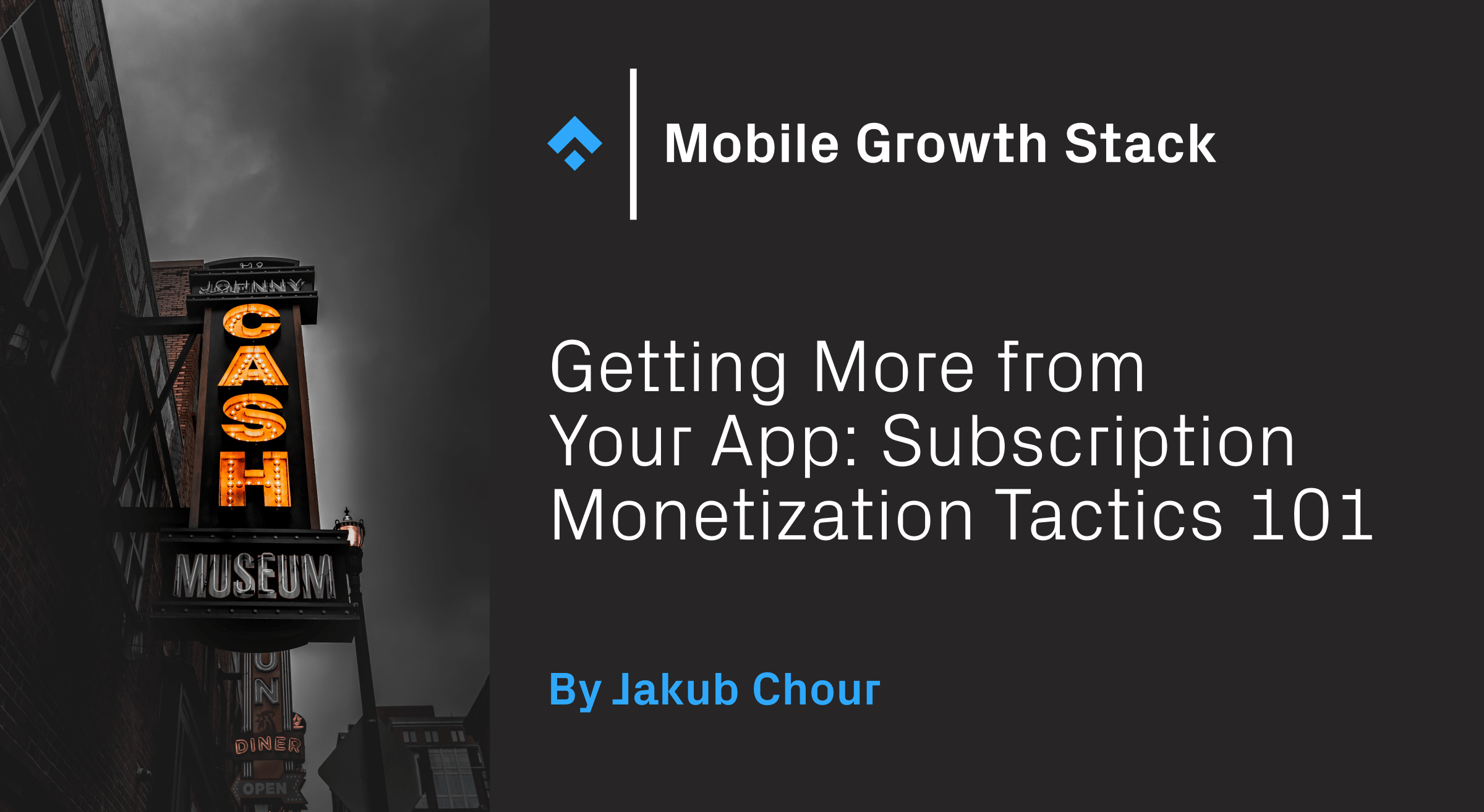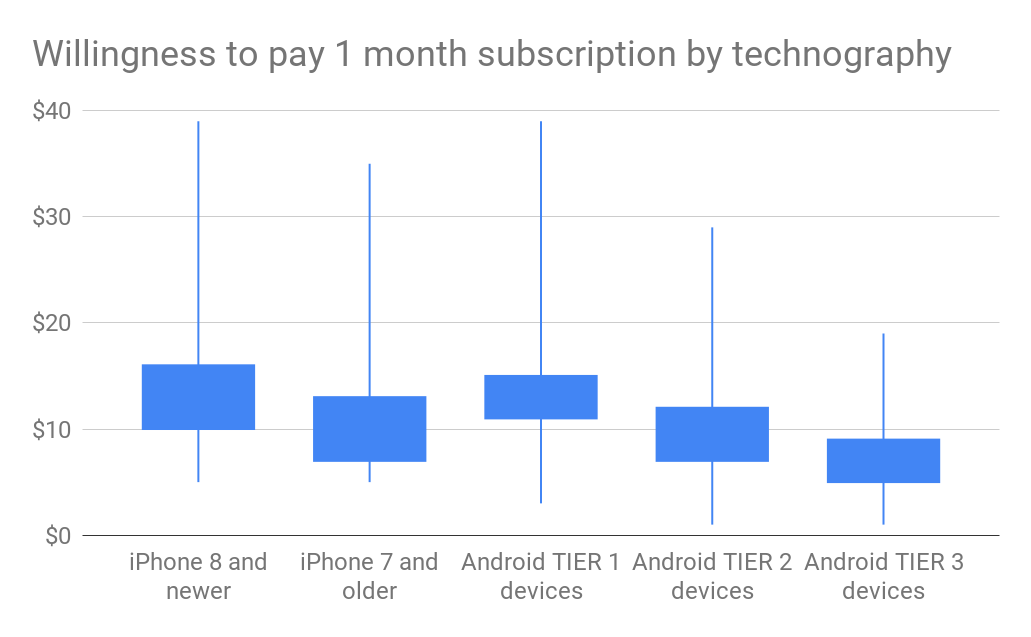
Editor’s note: This is a guest post from Jakub Chour. Jakub is co-founder of Digicamp.cz and currently works as a freelance mobile growth and subscription optimization consultant.
You’ve been in the app business for some time now. You’re doing ASO, CR, Retention Optimization, Ad-Revenue Optimization and the likes. But did you miss something? Yes, probably. Somewhere between Product, Marketing, and your Devs lies App Subscription Pricing, which can bring you additional revenue for no additional costs.
Where should you start?
As apps are moving from one-off purchases to freemium, you probably have your prices set already. If you were “lucky”, developers set it when they implemented a billing library—it more or less equals what your competition costs. The trouble of this approach lies in the fact that everyone else did it the same way, and that some of your users are probably willing to pay more. Of course, some would still pay, but less—if they had a chance.

1) Special Offers
The sad truth is that for the vast majority of subscription apps (games are a different animal), most of your subscribers will purchase them in the first seven days—the majority of them even sooner. Imagine a sleep diary app: 95% of all your purchases happen by day 7. On day 3, you’ll probably be at 90%. As you still have plenty of your users retained on day 3, you can show them some hefty offers (30%+ sale, for example) on that day without worrying that it’ll destroy your full-price purchase funnel. If you’re after revenue and not particularly keen on the brand, rinse and repeat in the rest of users’ days until you reach 99% of your sales target. As willingness-to-pay models show, there is always someone who is willing to pay less.
Or if you understand your subscription data well and you do a lot of UA, you can also do what Eric Seufert says: present first-session offers to users from paid channels to send early purchase event signals to ad-networks to better optimize. One way or another, it’s usually a quick-win if you haven’t done anything before in this segment.

2) Current Subscription Price Optimization
If you happened to set up your prices in 2017 and never looked back (a surprisingly large number of accounts that I’ve come across do that), it’s time to get right down to business. Not all countries are equal in purchasing parity and willingness-to-pay—which means you should price accordingly. If you’re barely starting off, you can compare your prices at a global level to Netflix or Spotify in order to find out how much you should charge. Don’t forget about your competition—but chances are that they did their pricing by doing the same thing.
If you’re on the market for a longer time, you can try to adjust your prices to match “charm” prices in all currencies. From there, you can try to raise it, as a hefty amount of users will pay more if you charge them. But how exactly?
Say you have your 1-month subscription for $14.99 at Google Play. When you set up your prices, you wanted to have one price for all regions. But due to tax differences, this makes it €15.99 in EU regions, which is $18.09 in the US. That’s slightly above what users might want to pay, as psychological pricing borders tend to be divisible by 5 (14.99, 19.99, …). Lower it to €14.99 and you can get a better conversion rate.
If you’re satisfied with the conversion rate you have, raise it to €19.99, as price elasticity between this interval tends to be low. A decreased number of purchasers will compensate with higher revenues.
All of this should be supported by experiments, or even better: with a pricing survey. (You might find that a portion of users are willing to pay $20.00—or that you should never try to do that).
3) Tiered Subscriptions
The notion of an “average user” does not exist. Users have different motivations and needs. Yet we are still using one-product-fits-all models. Yes, you’re probably offering longer and shorter subscriptions, but that still doesn’t count.
Think about Tinder. As a freemium service, they offer a subscription which allows you to be very active (unlimited number of likes and more in Tinder Plus), or, on the highest level, the option to message someone directly (Tinder Gold). We also know from game apps that removing ads is something users are willing to consider, for a reasonable price, to upgrade.
Surveys are not hard in themselves. Neither are uncomplicated in-app messages, which allow users to select the features they value most, subsequently separating it to the core (things that shouldn’t be monetized, like “swipes”), most desired (should be monetized most) and the nice-to-haves (like location change). Put together all your app features and let users choose what they want most. And then what is the 2nd most wanted feature and so on. There are other options like conjoint analysis, but a simple survey should do the trick if applied with common sense.
Also don’t forget that your product evolves and you don’t need to add all your new features to the current subscription/tier. You can create a completely new tier based on new features.
Even though creating tiers requires a higher notion of what users value as indispensable features, doing so can bring more than simple sales offers.

4) Lifetime Purchase
Maybe you have a pretty cool LTV from monthly subscribers. Maybe your yearly subscription renewals are over 27%—a really nice number to be at. But don’t forget that subscription fatigue is a real thing. And guess who will never churn from your premium: lifetime premium users.
Although it’s not technically a subscription product, It delivers the highest LTV possible, and it’s very viable for certain kinds of users. Should you offer it? I would give it a shot if there is a chance that there is long-term value in your app. Better than switching from freemium to monthly, paid each time a user stops using your app, you should consider offering it for at least a bit higher than your yearly sub LTV. With a reasonable pricing (think >$100), it can be your new LTV champion.
Dynamic Pricing
As we discussed previously, there will always be someone willing to pay more. Or less. And even if you adjust your pricing to each country and each life-cycle (renewing user, wants-it-all user, and more), you will always miss someone.
The obvious next-step is to tailor pricing for each user. It’s been a long-term trend on desktop, but mobile seems to be lagging behind. It’s also a bit harder to do, given that app stores are charging not at your paygate—but this shouldn’t stop you.
Forget about prediction models and AI. Firebase Predictions, for example, are really weak in predicting pricing, and custom models can cost you a fortune. Think of who converts the best. What device do those users have? Where are they from? Do you know the city? What do you know about them?
You can find a lot about users from what they don’t tell you. Every SDK returns a device model and manufacturer, and with each request, they’re sharing IP addresses. You might not be able to tell from scratch where they’re from, but you can find out more with services like IP Quality Score. When you match your buyers with their information, you’re already building a strong best-practices guide.
You can also make use of what your users tell you. Take the following example: health and fitness apps. In many, you’re asked during onboarding about your goals, how much you weigh, and what your target weight is. Users with reasonable goals in mind also tend to convert better as—in theory—they know what they’re doing, and the app will help them.
See the attached graph with an example technography data survey. You can see that there are differences in between device-related conversion-rate. iOS device users are willing to pay more in general. But so does owners of the TOP Android devices. No need to lower your Android prices for all users as it happens for some developers. And You will likely see similar results for the key data users will provide you.

I understand you might not want to take advantage of your users’ sensitive information. But trade it off by making a cheaper subscription for those who have bigger challenges. The decision is yours.
Table of Contents












